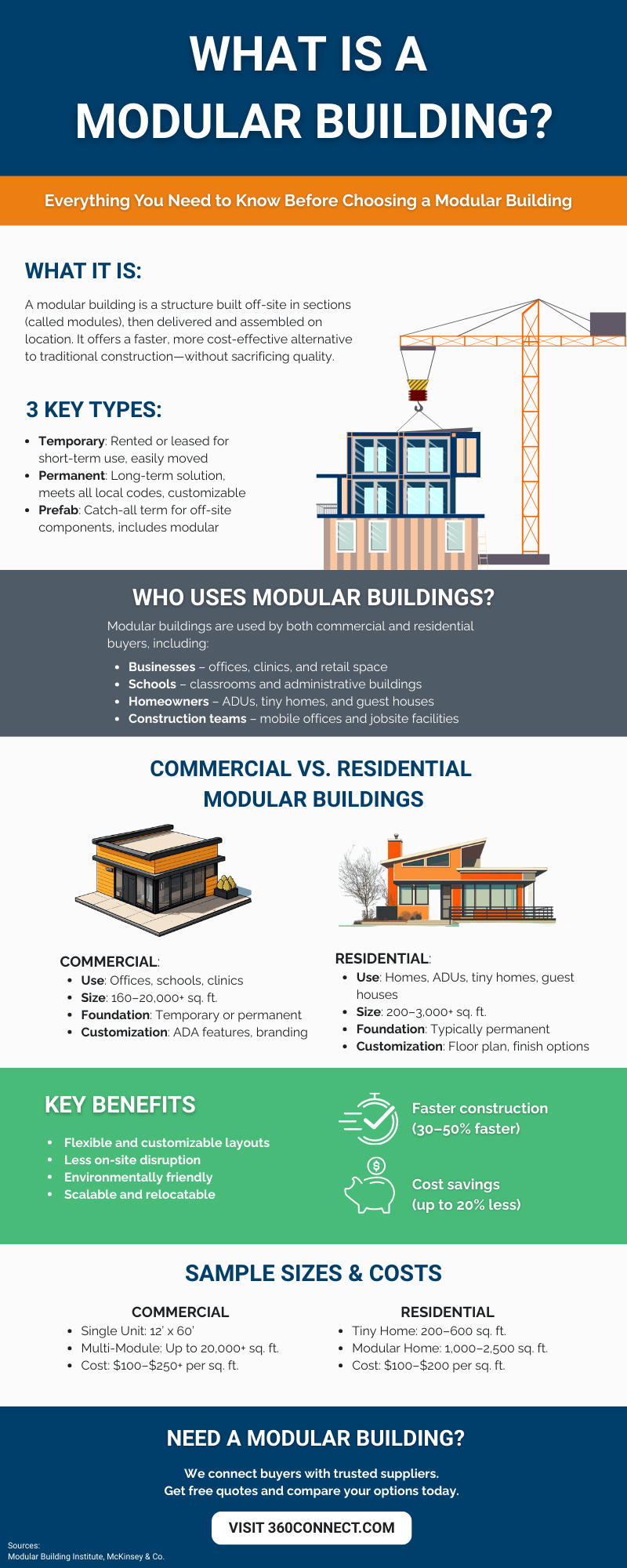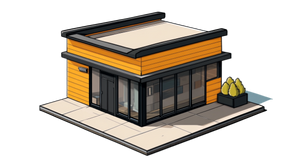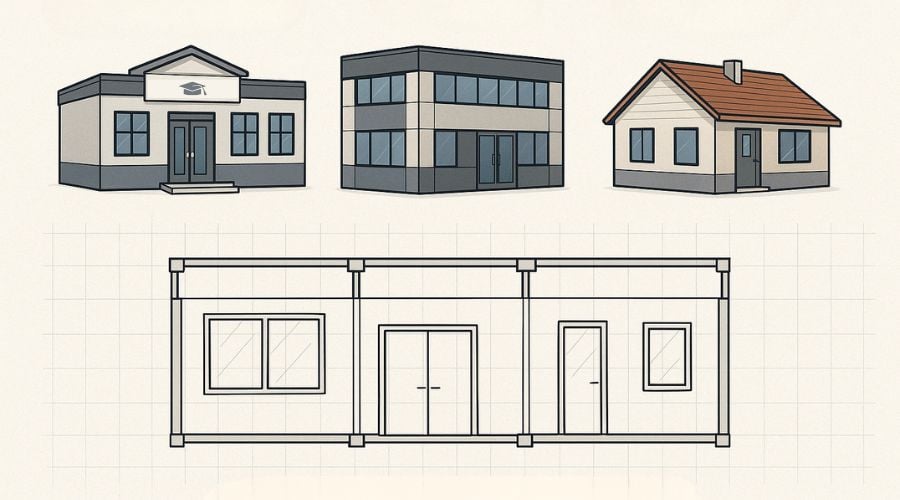Modular buildings are changing the way we think about construction. Whether it’s for commercial, residential, or even temporary use, these structures offer a flexible and efficient alternative to traditional building methods. But what is a modular building, and how does it work?
A modular building is a structure constructed off-site in a controlled environment, using individual sections called modules. These modules are then transported to a prepared site and assembled into a complete structure. This method allows builders to speed up timelines, reduce waste, and cut costs—without sacrificing quality.
In this blog, we’ll break down exactly what a modular building is, who uses them, the differences between residential and commercial types, and why modular construction continues to grow in popularity across industries.
What is a Modular Building?
A modular building is a prefabricated structure built off-site in sections—called modules—which are transported to a prepared location and assembled into a complete building. These modules are constructed in a factory, using the same materials and codes as traditional buildings, then delivered and installed much faster than standard construction.
Overall, modular buildings fall into a few main categories:
- Temporary Modular Buildings:
Businesses and organizations use these for short-term needs like mobile offices, classrooms, medical units, or temporary housing. You can rent or lease them, move them to new locations, and reconfigure them as your needs change. - Permanent Modular Buildings:
These are designed for long-term use and made to meet the same local codes as traditional, on-site structures. Once installed, they can be indistinguishable from stick-built structures and may include full foundations, multi-story layouts, and custom interiors. - Prefabricated (Prefab):
“Prefab” is a broad term that includes modular buildings, but also refers to panels, pods, or components made off-site and assembled on location. All modular buildings are prefab, but not all prefab buildings are modular.
BOTTOM LINE:
Whether you’re looking for a short-term space solution or a permanent structure, modular construction offers speed, savings, and flexibility—with fewer delays and less waste.

Who Uses Modular Buildings?
They are a popular choice for both business owners and homeowners. If you need more space, want to avoid the long timelines of traditional construction, or are working with a tighter budget, a modular building might be the right fit for you.
Here are just a few ways they are used for commercial or residential needs:
- Businesses that need extra office space, medical clinics, classrooms, or retail shops
- Homeowners looking for affordable housing, tiny homes, or backyard guest houses
- Schools or nonprofits needing fast, flexible space solutions
- Construction companies in need of jobsite trailers or workforce housing
Let’s explore how they work in both commercial and residential settings.
Commercial Modular Buildings
If you run a business and need to expand quickly, modular buildings can help you add professional, code-compliant space—without disrupting your operations for months.

Common Uses for Commercial
- Offices – Temporary or permanent workspace
- Schools – Additional classrooms, admin buildings
- Healthcare – Clinics, labs, testing centers
- Retail – Pop-up locations, seasonal storefronts
- Construction Sites – Jobsite offices, breakrooms, storage
- High-Risk Environments – Blast resistant modules for oil & gas, military, and industrial safety zones
They’re a great fit when you need to scale up fast, stay within budget, or respond to changing demand.
Common Sizes for Commercial Use
- Single-wide units: 8’ x 20’ to 12’ x 60’
- Double-wide units: 24’ x 60’ or larger
- Multi-module buildings: 2,000–20,000+ sq. ft.
- Stacked, multi-story buildings: Add vertical space with multiple modules
Whether you need one room or an entire campus, modular can scale with you.
ADA Compliance
Most commercial modular buildings can be configured to meet ADA (Americans with Disabilities Act) requirements. That includes:
- Accessible restrooms
- Ramps and wide doorways
- Grab bars and ADA-compliant hardware
- Layouts designed for mobility aids
Be sure to confirm local accessibility requirements with your supplier.
How Much Do Commercial Modular Buildings Cost?
Modular construction can reduce overall costs by up to 20% compared to traditional methods.
Here’s what to expect:
- Leased modular offices: $1,000–$3,000/month
- Purchased modular buildings: $100–$200+ per sq. ft.
- Custom or permanent solutions: $250+/sq. ft., depending on finishes and design
Pricing will vary based on building size, layout, materials, and whether you choose to rent or buy.
Residential Modular Buildings
Looking for a cost-effective alternative to traditional housing? Modular homes offer a quicker and more affordable way to build—without cutting corners on quality.

Common Uses for Residential
- Primary homes
- Tiny homes or ADUs (Accessory Dwelling Units)
- Vacation cabins
- Guest houses or in-law suites
Moreover, they provide flexibility in both layout and design to fit your lifestyle and your lot.
Common Sizes for Residential Use
- Tiny homes / ADUs: 200–600 sq. ft.
- Single-family homes: 1,000–2,500 sq. ft.
- Multi-family setups: Duplexes or small apartment layouts up to 3,000+ sq. ft.
So, whether you’re creating a cozy getaway or your forever home, it can meet your needs.
How Much Do Residential Modular Buildings Cost?
Modular homes are generally more budget-friendly than traditional homes. According to Rocket Mortgage, the average modular home costs $100–$200 per square foot, compared to $150–$250 per square foot for traditional structures.
Here’s a general price range:
- Tiny modular homes: $40,000–$80,000
- Standard modular homes: $120,000–$300,000+
- Luxury/custom modular builds: $300,000–$500,000+
Modular homes often qualify for traditional mortgage financing and can be customized to match your style and budget.
Commercial vs. Residential Modular Buildings
Here’s a quick breakdown of how they are used in both commercial and residential settings:
| Feature | Commercial | Residential |
| Best For | Offices, schools, clinics, retail, jobsite trailers | Homes, ADUs, guest houses, vacation cabins |
| Size Range | 160 sq. ft. (single units) to 20,000+ sq. ft. (multi-module complexes) | 200 sq. ft. to 3,000+ sq. ft. |
| Customization | Office layouts, ADA features, branding | Floor plans, kitchen & bath finishes, exteriors |
| Code Compliance | Commercial codes, IBC, ADA | HUD or local residential building codes |
Both types use the same construction process—but how you use the building depends on your goals.
Benefits of Modular Buildings
Here’s why more people are turning to modular buildings as a smarter way to build:
Faster Construction
They can be completed 30%–50% faster than traditional construction because the site prep and module build happen at the same time.
Cost Savings
Because they are built in factories, material waste and labor costs are lower. This can reduce your total project cost by up to 20%.
Customization
From layout to materials, they are highly customizable. Choose finishes, floor plans, accessibility features, and more to match your style or brand.
Sustainability
Modular construction produces less waste, has a smaller carbon footprint, and often uses energy-efficient materials. Many buildings can be built to meet LEED or Energy Star standards.
Less On-Site Disruption
Because most of the work is done off-site, they create less noise, dust, and downtime—especially helpful for schools, hospitals, and residential neighborhoods.
Expandable and Relocatable
Need more space later? Just add more modules. Need to move your building? Many modular structures can be relocated or reconfigured as your needs change.
Final Thoughts on What is a Modular Building
So, what is a modular building? It’s a fast, flexible, and cost-effective alternative to traditional construction—whether you’re building a business, expanding your school, or designing your dream home.
With faster timelines, smart design options, and budget-friendly pricing, modular buildings are helping people across the country build better.
Ready to Get a Modular Building?
At 360Connect, we make it easy to compare top modular building providers and find the best fit for your project. Whether you need a commercial office or a new home, we’ll help you get connected—fast.

